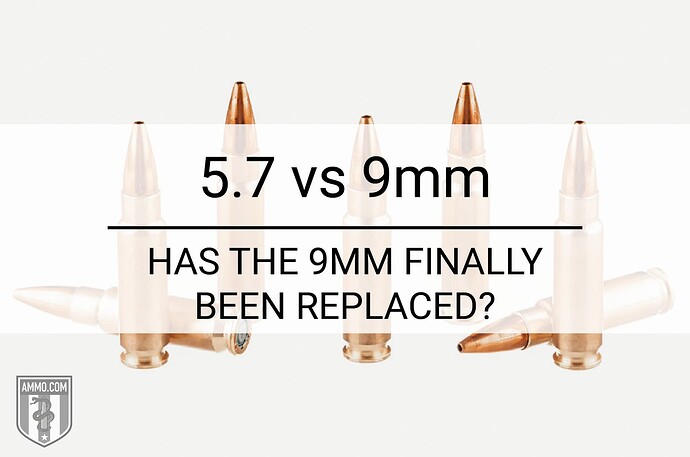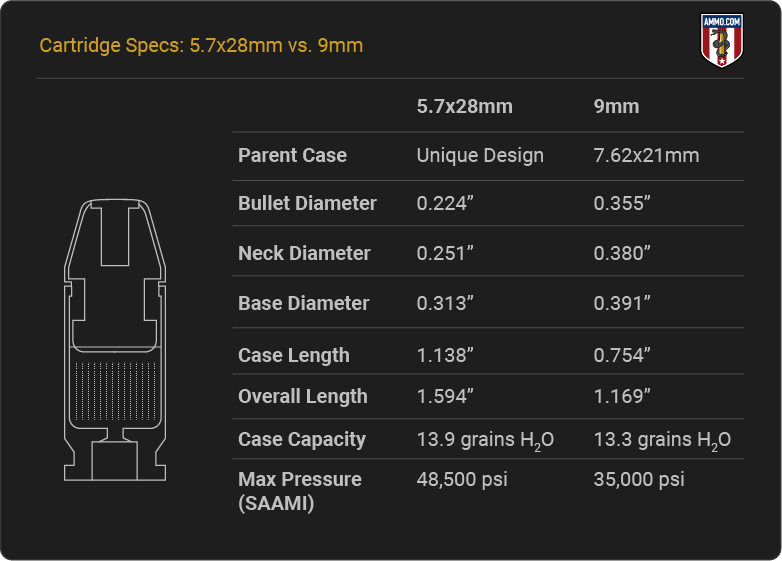When you first start comparing the 9mm and 5.7x28mm, you might think they’re radically different. The 9mm looks like a traditional semi-automatic handgun cartridge, and its bullets are significantly heavier.
Conversely, the 5.7mm resembles a miniature semi-auto rifle cartridge. Its bullets are much lighter, and also appear to be more aerodynamic.
Are the two rounds really as different as they seem to be – and if they are, does the newer 5.7 succeed at outperforming the 9mm? Or are the 9mm loyalists (such as myself) correct when they say there’s no real advantage to switching over? Let’s thoroughly compare the rounds and determine the winner of the 5.7 vs. 9mm debate once and for all!
5.7mm vs. 9mm: Differences and Similarities
FN Herstal developed the 5.7 to replace the 9mm: a challenging task. If FN Herstal succeeded, then we should expect the 5.7 to outperform the 9mm in nearly every measurable aspect.
Don’t count on the 9mm to go down without a fight, though. There are good reasons why it’s stayed so popular for over 120 years. Convincing its many fans to switch will prove challenging no matter the conclusion of this article.
| Category | 5.7x28mm | 9mm | Winner |
|---|---|---|---|
| Recoil | Lower recoil | Heavier recoil | 5.7x28mm |
| Trajectory | Extraordinarily flat for a handgun cartridge | Typical of a handgun cartridge | 5.7x28mm |
| Accuracy | More accurate due to lower recoil and flatter trajectory | Reasonably accurate, albeit with higher recoil and steeper bullet drop | 5.7x28mm |
| Stopping Power | Lesser due to lighter, narrower projectiles | Greater due to heavier, wider bullets | 9mm |
| Ammo Cost & Availability | Costs more; less abundant | Costs less; more abundant | 9mm |
| Firearm Options | Sparse | Virtually limitless | 9mm |
| Ballistic Performance | Higher velocity, flatter trajectory | Lower velocity and higher trajectory | 5.7x28mm |
| Self-Defense Suitability | Lighter recoil, higher magazine capacity, accurate | More training ammo available, more self-defense ammo options, more firearm options, less expensive overall | 9mm |
Cartridge Specs
The 5.7x28mm cartridge is narrower but longer than the 9x19mm Parabellum.
Most 9mm bullets weigh 115, 124, or 147 grains; substantially heavier than the 5.7’s usual 27 and 40 grain bullets.
The 5.7’s narrower, lighter bullets permit the design of higher-capacity magazines, thus enabling the shooter to carry more rounds.
If you’re looking for a small yet powerful round – like many law enforcement and government agencies currently are – then the 5.7 easily wins this matchup.
Recoil
Neither cartridge is known for having heavy recoil. Fans of the 9mm often argue that this is one significant advantage in the 9mm vs. 44 ACP debate, as follow-up shots tend to be more accurate when there is less recoil.
However, the 9mm has been outdone in terms of recoil. Although it may attain higher muzzle velocities, the 5.7’s lighter bullets and powder charges grant it undeniably lighter felt recoil. I’ve never considered the 9mm to have overbearing recoil, even while firing heavy self-defense loads. Even so, the 5.7 kicks more softly.
Granted, a heavier firearm will produce less recoil, although carrying one around all day can be tiring.
I give the advantage to the 5.7. It generates around one-third less recoil than the 9mm – the latter of which isn’t known for having much recoil in its own right.
Trajectory
Since both rounds are designed for handguns and submachine guns, their trajectories will not be as impressively flat as those belonging to cartridges intended for long-range shooting.
Most shooters prefer a flat trajectory, because it requires fewer calculations and adjustments.
At close range, differences between these rounds’ trajectories are minimal. However, the faster bullets of 5.7 ammo exhibit flatter trajectories than the bulkier 9mm rounds as distance to the target increases.
The 9mm was designed to be lethal out to 50 meters. While it is technically lethal beyond that range, the bullet’s trajectory doesn’t allow it to be effective at long range – even when fired from a carbine.
The 5.7 was developed to effectively pierce body armor at 200 meters. It needs a flat trajectory to be accurate at that distance – the reason why it wins this category.
Continue reading 5.7 vs. 9mm: Has the 9mm Finally Been Replaced? on Ammo.com

